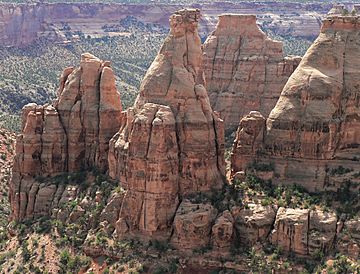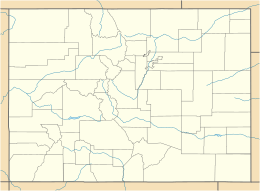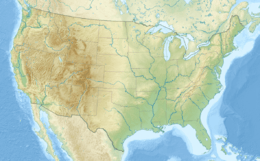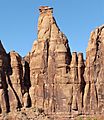Pipe Organ (Colorado National Monument) facts for kids
Quick facts for kids Pipe Organ |
|
|---|---|

Northwest aspect
|
|
| Highest point | |
| Elevation | 5,731 ft (1,747 m) |
| Prominence | 241 ft (73 m) |
| Isolation | 0.28 mi (0.45 km) |
| Parent peak | Independence Monument |
| Geography | |
| Location | Colorado National Monument Mesa County, Colorado, U.S. |
| Parent range | Colorado Plateau Uncompahgre Plateau |
| Topo map | USGS Colorado National Monument |
| Geology | |
| Age of rock | Late Triassic to Early Jurassic |
| Type of rock | Wingate Sandstone |
| Climbing | |
| First ascent | January 31, 1961 |
| Easiest route | class 5.10 C1 climbing |
Pipe Organ is a tall, thin rock pillar made of sandstone. It stands 5,731 feet (1,747 meters) high in the Colorado National Monument. You can find it in Mesa County, in western Colorado, United States.
This amazing 400-foot rock tower is located in Wedding Canyon. It's less than half a mile east of the monument's visitor center. It's also about 9 miles west of the town of Grand Junction. Pipe Organ is right next to Independence Monument, another popular climbing spot. You can see both from viewpoints along Rim Rock Drive.
The first people to climb to the very top of Pipe Organ were John Auld, Gary Ziegler, Jim Dyson, and John Kuglin. They made their historic climb on January 31, 1961. Pipe Organ has a smaller peak nearby called Organ Pipe Spire. The National Park Service sometimes calls this smaller peak Praying Hands. This 325-foot-high peak was first named Squall Spire in 1976 by Harvey T. Carter.
Contents
What is Pipe Organ Made Of?
Pipe Organ is a leftover piece of rock that was shaped by wind and water over millions of years. It's mostly made of a type of rock called Wingate Sandstone. This sandstone formed from ancient sand dunes about 200 million years ago. Imagine huge deserts with sand blowing everywhere!
The very top of Pipe Organ has a harder layer of rock called the Kayenta Formation. This layer helps protect the softer sandstone below. Around the bottom of Pipe Organ, you'll find rock from the Chinle Formation. The very bottom of the canyon has even older rocks. These are Precambrian rocks like gneiss, schist, and granite. Water that runs off Pipe Organ eventually flows into the Colorado River.
What is the Weather Like at Pipe Organ?
The area around Pipe Organ has a semi-arid climate. This means it's quite dry. Summers are hot and don't get much rain. Winters are cold and can have some snow.
Temperatures can reach 100°F (38°C) on about 5 days each year. They often get to 90°F (32°C) on about 57 days. On the other hand, temperatures stay at or below freezing for about 13 days each year. The best time to visit Pipe Organ is from April through October. The weather during these months is usually the most pleasant.
Can You Climb Pipe Organ?
Yes, Pipe Organ is a popular place for rock climbing! Many different routes have been set up on Pipe Organ and its smaller neighbor, Organ Pipe Spire. Climbing routes are rated by how difficult they are.
Here are some of the climbing routes:
- Southeast – This route is rated class 5.10 C1. It has 3 sections, called pitches. This was the first route climbed in 1961.
- Southwest Face – This route is rated class 5.10+ C2 and has 3 pitches.
- Organ Pipe Spire – This route on the smaller spire is rated class 5.8+ and has 2 pitches.
- Sirocco – This route is rated class 5.9. It was first climbed in 1976.
- Pipe Dream – This route is rated class 5.11+ and has 5 pitches. It was first climbed in 2005.
- Aces & Eights – This route is rated class 5.12 C2 and has 4 pitches.
- Ender's Game – This route is rated class 5.10 and has 3 pitches.
- The Weird Fun – This route is also rated class 5.10 and has 3 pitches.
Images for kids







